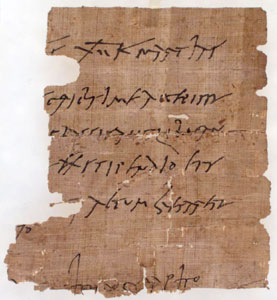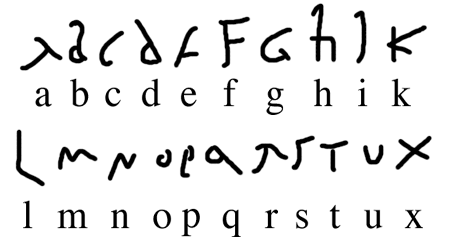P.Mich.inv. 4301: an IntroductionThis interactive project is part of the series Reading the Papyri, a learning resource for K-12 and college students interested in classical languages and ancient history. In this project, you will be taking an in-depth look at a documentary Latin text from the University of Michigan Papyrus Collection. Nearly all of the papyri that survive today come from Egypt, since the region's climatic conditions are ideal for preservation. Latin texts from Egypt are relatively rare, as the major languages used in Egypt were Greek, used in government and among the upper class, and Egyptian, used by the common people. However, several Latin texts from Egypt do exist, due mainly to the presence of the Roman army in Egypt. Inventory number 4301, while not a military document, comes from this context of the Roman army. The FragmentP.Mich.inv 4301 consists of a single fragment, preserving the upper and right-hand margins of the text. A considerable amount of text to the left and below has been lost. There is writing on the recto only; the verso is blank.
PalaeographyThe most striking feature of this papyrus, for students without a background in Latin palaeography, is the cursive hand in which the text is written. While this hand is typical of cursive Latin hands of the period, it will likely be difficult for many to read. Nevertheless, the fundamental similarities between the cursive lettershapes in this document and the well known shapes of the Roman alphabet are demonstrated in the alphabet below, which gives an idea of the general forms used in this text:
The TextThis text is a private contract outlining the terms of a loan taken by a Roman soldier. In this contract, the soldier acknowledges receipt of the money and agrees to repay the sum with interest. Although much of the text is lost, we will see that the remainder of the document can be reconstructed based on parallels with other similar documents. The reconstruction we follow in this text is given by Bruckner and Marichal, Chartae Latinae Antiquiores V 294. The Significance of the TextDocumentary texts such as this one provide a unique insight into daily life in the ancient world, a view that one cannot get from literary sources alone. Once the debt was repayed, this piece of papyrus probably lost any worth or significance to its ancient authors, but to a modern audience it can be a valuable tool for imagining life in a civilization two thousand years past. |
| Copyright 2004 The Regents of the University
of Michigan. Reading the Papyri is produced by the University of Michigan Papyrus Collection These pages designed and written by Terrence Szymanski. email: papywebmaster@umich.edu |

